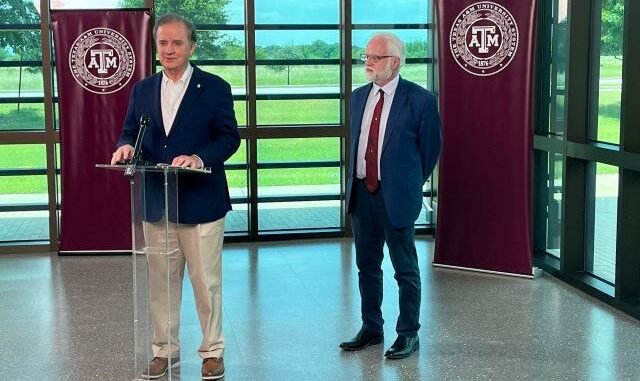
Nuclear power plants are coming to the Texas A&M system’s RELLIS campus in west Bryan.
System chancellor John Sharp told reporters Wednesday (May 29) that they have targeted locations to build four or five reactors from different manufacturers that would take care of rising electrical demand on a permanent basis.
Sharp says they have been working on this project for more than six months. He says his interest came after looking at power projections for companies involved in artificial intelligence.
Joining the chancellor at Wednesday’s news conference was Dr. Sean McDeavitt, a system associate vice chancellor who heads the National Laboratories Office. McDeavitt and Sharp both brought up the student involvement in this project. McDeavitt said the student education component is a key element in the request for information (RFI) process that has started.
Sharp said companies can respond to the system’s RFI announcement for three weeks. That will be followed by a 30 day period for requests for proposals (RFP). After the RFP’s are reviewed by a committee, Sharp says recommendations will go to the board of regents for final action.
Wednesday’s announcement comes the week after Sharp said the system was taking proposals to build power plants on system properties around the state to provide electricity on a short term basis.
Click below to hear comments from John Sharp and Sean McDeavitt, visiting with reporters on May 29, 2024:
News release from the Texas A&M system:
Leaders at The Texas A&M University System announced plans Wednesday to bring the latest nuclear reactors to the Texas A&M-RELLIS.
John Sharp, chancellor of the Texas A&M System, said the System seeks to provide a platform for companies to test the latest reactors and technologies. It also will address the pressing need for increased power supply.
“As Texas continues to grow, it is critical that we add more reliable, dispatchable power for all Texans,” said Governor Greg Abbott. “Texas A&M’s announcement to bring advanced nuclear technologies to its RELLIS campus is essential for Texas to expand our nuclear power capabilities that will help bolster our electric grid. Nuclear energy will continue to play an integral role in Texas so we can continue to meet the energy needs of our great state for generations to come.”
The next generation of nuclear reactors, with a potential power capacity ranging from 10 MW to 1 GW, have the potential to revolutionize power generation and meet the vast energy requirements of Texas. The new generation of reactors also could provide vital power sources for artificial intelligence companies, Sharp said.
“We at the Texas A&M University System understand the global need for more power,” Sharp said. “And we are positioned to bolster our grid and to provide the power for the latest technologies. We believe that nuclear power is the only solution to provide quick, clean, carbon-free and reliable energy to prevent blackouts and to foster innovation.”
To kickstart the latest nuclear initiative, the Texas A&M System will be seeking information – and later proposals – from manufacturers of nuclear reactors. Ultimately, the site could host multiple electrical power-generating facilities, and it could host first-of-a-kind reactors with a net increase of up to 1 GW of capacity that will have a direct connection to the grid operated by Electric Reliability Council of Texas, Inc., or as it is more commonly called, ERCOT.
Sharp said the Texas A&M System is committed to developing power generation capabilities to ensure reliable electrical power provision to the RELLIS campus.
“This effort at Texas A&M-RELLIS will usher in a new era of sustainable and reliable power generation,” Sharp said.
Representatives from the System and from the companies hope to stand up operational reactors within the next five to seven years.
